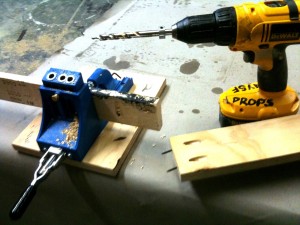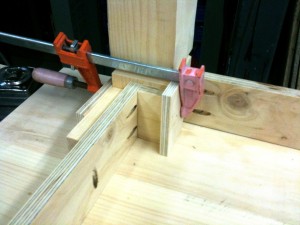I’ve just returned from this year’s USITT in Charlotte, NC. I have a lot going through my head at the moment, so I’ll show off some of the video I shot at the Tech Olympics. Each year, undergraduates at USITT can compete in these Olympics in a variety of events, such as knot-tying, hanging and focusing lights, and folding a drop. Many technical theatre departments have their own event. For props, the challenge is to strike a table setting to a prop table, and set up a different table setting. Randy Lutz and Tracy Armagost from the Santa Fe Opera were the judges. Contestants are ranked by the speed they complete the task in, but they are penalized for things such as missing their spike marks, making too much noise, or dragging a tablecloth on the ground. I filmed DH from Elon University doing the challenge so you would not miss out on all the fun:
Tag Archives: table
More on a Wooden Table
In the previous post, I spoke about the wooden table we were building for The Last Cargo Cult.

Jay Duckworth started off with a coat of darker stain to catch the raised grain and really accentuate it. He went over the whole thing again with a lighter shade. After it appeared on stage during tech rehearsal, Peter Ksander, the designer, wanted to see it a bit darker and richer. I added a light coat of Red Mahagony stain, which got it where it wanted to go; we sealed it with a thin coat of water-based polyurethane. You may have noticed some boxes behind the table, which were the other major props challenge on this show. Below is a wider shot to show the full tableau.

Meredith Ries, who helped us out with a lot of the box work, has a more extensive write-up on the cardboard boxes at her own blog. The pile is about sixteen feet high at its tallest point.
The Last Cargo Cult is currently in previews and opens this Monday, December 7th.
A wooden table
The last show for the calendar year at the Public Theatre is Mike Daisey‘s “The Last Cargo Cultâ€. We needed to construct a new table to match the design of the world. The design called for a solid, fairly sturdy-looking wooden table, which showed some character and a lot of age.

The table top was made of four planks of equal length. I connected them using a biscuit joiner. I was able to borrow the scene shop’s new Woodcraft bar clamps for this. You alternate whether the clamps go over top or underneath the surface to keep it from bowing. I also clamped a metal bar on either end as an additional way to keep the planks level with each other. You can ignore the random one by four in the photograph; I’m not sure why that was there.

I used wax paper to keep the glue from squeezing out and adhering the wood to the work table, or worse, dripping onto the clamps. If you wipe the excess glue away, you will smear it into the wood. It may look like it’s gone, but when you go to stain the piece, it will not accept the stain and you will be left with light-colored spots. Wait until the glue dries and then scrape it off. If you are painting the table, or the glue is in a hidden place, then by all means, wipe away while wet.

Here is the final table top. I used a belt sander, starting with a 50 grit belt, then skipping straight ahead to 12o grit, and finishing with 320 grit. I then hit it with a random orbital sander at 400 grit. Peter Ksander, the set designer, wanted to bring out the grain and accentuate the pattern. I wiped the surface with a wet rag. This causes the dark grain to raise up from the lighter grain; if you were aiming for a smooth surface, you can then sand the higher grain down, but in this case, I left it alone.

Karen Cahill, the properties manager at George Street Playhouse, was on hand for a bit to help out. She glued the boards together to make the blocks for the legs. I made a taper jig to quickly replicate a taper onto all four legs. I used the band saw as the table saw could not raise high enough to cut it in one pass.

Easily one of my favorite new tools of the year is the Kreg Pocket Hole Jig. You can see in the photograph above how it allows you to drill holes so the screws exit the center of the end grain. For prop carpentry, the speed and strength of the joints it creates have replaced many of the joints I use regularly. For tables, I use them to attach the apron to the legs, followed by the apron to the top. This allows me to keep the top of the table free from screw or nail holes.

You need to clamp the pieces well to keep them from drifting; the pocket hole jig creates a hole at a slight angle, so the screw will want to push the wood back as it drives in. Above, you can see the various pieces of wood we used to not only hold the apron in place while we attached it to the leg, but also to space it consistently on all the legs. Jay Duckworth was on hand for much of this part as well. He also routed the groove you see in the legs below and stained the table at the end of the day.


